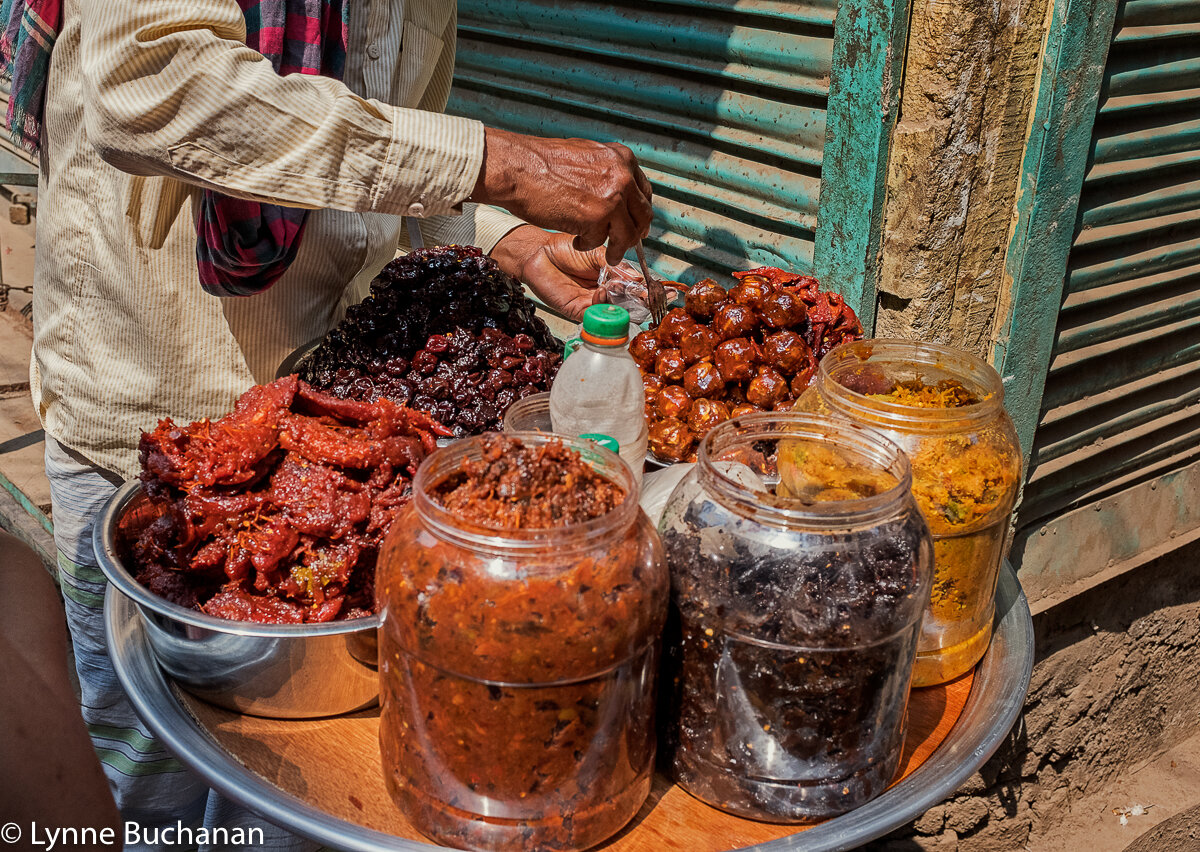The Streets of Old Dhaka
Sheet Metal Vendor, Old Dhaka
One of the most interesting experiences I had in Bangladesh was being taken through the streets of Old Dhaka by Sohag Mohajon, who volunteers for the Buriganga Waterkeeper and lives in the area. Most of the time I was in Dhaka, I was either inside an apartment or a car. The country is problematic for tourists in the city, although it was possible to walk around in the Tea Gardens, Rain Forest and the Sundarbans. I really enjoy connecting with people and seeing the culture, so it was a real treat when I got to walk around and have honey cakes and tea in a little shop and see what people were selling on the streets.
Old Dhaka, Pineapple Vendor
The colors of people's attire added so much to the scene. So many dressed so meticulously, both men and women. Though there is a lot of poverty in Bangladesh, people do take great care with their appearance. As a tourist, I dressed to be modest, but often I felt so slovenly next to people in the city. When I got home, I read this great article about fashion in Bangladesh. It ends with the following observation, "Many styles have come and gone within this period but one thing has definitely remained constant throughout it all was the obsession of the people of Bengal, to look their best through thick and thin." (http://www.thedailystar.net/lifestyle/fashion-through-the-years-bangladesh-1355911)
Old Dhaka, Street Pickles
There were so many varieties of pickles on the street. I loved the rich colors from all the spices.
Pickle Vendor, Old Dhaka
The vendor was such a gentle soul and so proud of his offerings. He is dressed in traditional attire for the men, wearing a lungi, the piece of cloth made of cotton, silk or batik that the men wrap around. I suspect it is cooler than pants in the heat. Lungis are very popular in rural areas, but they are worn in cities too.
Newspaper Man, Old Dhaka
I could have walked around the streets all day taking everything in and noting all the cultural differences. The old part of town is so enjoyable because it is a pedestrian area.
Electrical Wiring, Old Dhaka
The government estimates that about 70 percent of the population has electricity now. However, the wiring is definitely interesting. Sometimes power is shut off in a process called shedding, which serves to conserve power in the city of 20 million people.
Old Dhaka Sugar Cane Vendor
There are 30 varieties of sugarcane in Bangladesh, but farmers are reducing their production of this crop since it is an annual and land has to be dedicated to it year-round. With floods and monsoons, the country is having a difficult time producing enough rice for its population. Rice is a major staple in the diet of people here, so some of the land that sugarcane was grown on is being taken over by rice and other more profitable crops.
Dhaka Gate, Erected by Mir Jumla
This gate was erected by Mir Jumla, who was appointed Governor of Bengal in 1660. Trade and commerce took off in the capital city, with people coming from Holland, France, England, Greece and Armenia to do business. Now this landmark is in disrepair and nothing is being done to preserve it.
Old Dhaka, The Group of Volunteers Who Showed Me Their Town
The group in the photo above are the wonderful people who escorted me through Old Dhaka. I felt so honored that they came out and brought flowers for me. The woman who is second to the right is from Belgium and works for First Defenders, who provide legal help for people in developing countries who are standing up for their human rights. I was treated with such incredible respect and people were so gracious and grateful that I came to see the plight of their waterways. Often our media only shows the problems in these countries and people fighting or suffering or refugees. They paint a scary picture of otherness, but walking through the streets with my hosts I felt included and befriended. There is something very special about truly honoring one another with such good will. I always raised my children to accept and celebrate diversity, but often living in homogenous suburbs it was just a theory. When connections like this are experienced, otherness disappears and that most certainly is the strat to healing and working together to solve the problems our entire globe is experiencing.
Dhaka Jute Holiday
There is just one more image I wanted to share and that is the one above. The day I visited Old Dhaka was a national Jute holiday. There were photos and billboards of jute all around the city. Though it is not as popular today as it once was, the country is making an effort to revitalize it. There was even a slogan for the day, "Golden Fiber, Golden Country. When I was this woman walk buy and look up a the glamorous women in the photograph while she was so glamorous herself, I had to roll down the car window and take the shot. It was especially beautiful to see the conventional dress and materials being celebrated. The people of Bangladesh are not without pride. Though their country suffers from many problems associated with climate change and overpopulation, that does not mean that they are lesser people. On the contrary, the resilience, steadfastness, and dignity they exhibit in the face of critical environmental crises made me realize how remarkable the Bengali people are and how much I can learn from them about not giving up.










